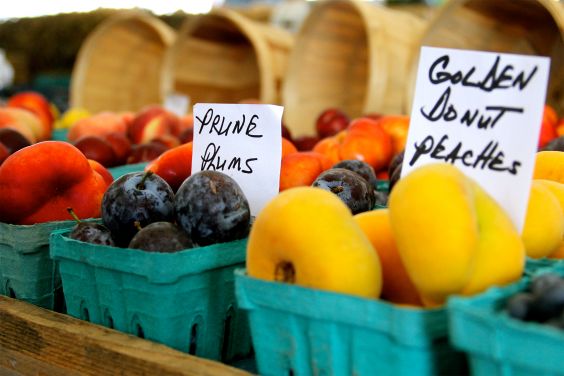For those of us lucky enough to live near a farmer’s market, summer is an amazing time to hit one up. In addition to the dog-and-people-watching opportunities, it’s a chance to support local farmers and eat the freshest, nutrient-packed produce money can buy.
Speaking of money, the idea that farmer’s markets are more expensive than the supermarket isn’t really true— especially when you’ve got the right game plan. Knowing what to look for and what to ask vendors can save you some cash, add market-fresh ingredients to your meals, and give you that “I’ve really got my life together!” feeling as you stroll past a sidewalk brunch crowd with a few greens strategically sticking out of your bag.
Get the Lay of the Land
“Each stand has its own prices, growing practices, and quality standards. You’ll quickly find your favorites,” says Catherine Crawford, communications director for New York City’s Greenmarket. That’s why it’s best to do a lap and check out all of your options before committing to the first tempting fruit stand you see.
And if you’ve considered hitting the market right before it closes to scoop up everything-must-go bargains, when it comes to quality, know that earlier is definitely better.
“Unlike grocery stores, farmers plan to sell out by day’s end,” Crawford says of the possible slim pickings. And just like you, certain veggies tend to wilt after hours under the hot summer sun—a morning visit will save both you and your arugula from the punishing rays. “Although tomatoes don’t mind hours in the sun, lettuce does,” Crawford advises. “What’s not sold out by the afternoon may well be wilted.”
Set Your Sights on Summer Produce
Nothing says summer quite like the taste of a juicy peach or some butter-slathered corn on the cob. Luckily, you can find these and more popular seasonal gems like basil, berries, cucumbers, and snap peas at most farmer’s markets around the United States. Then there’s the less-expected produce that varies by region—tomatillos, kohlrabi, and summer apple names you’ve never heard before. Consider it the perfect opportunity to be adventurous.
“Lesser-known summer favorites include figs—which are so sweet and gooey-ripe at the farmer’s market—shelling beans that are fresher and more tender than the dried kind, and as we get later into summer, a rainbow of sweet peppers and hot chilies,” says Brie Mazurek, communications director for the Center for Urban Education about Sustainable Agriculture (CUESA), which operates three Bay Area farmer’s markets.
Buying fruit and vegetables in their peak season is the key to the biggest bargains and the best taste: You might overpay for sour cherries in June, while every stand is overflowing with supply a month or two later. Keep track of your favorite produce’s peak season by consulting a seasonal chart by state online. “Buying what’s in season means that farmers sometimes have bargains on crops that are plentiful,” Mazurek points out.
If a farmer’s not too swamped to take questions, striking up a conversation about what’s in peak season can be incredibly fruitful… literally. “Some farmers kindly offer tastes or samples, so taste if you are considering buying something—but don’t just graze your way through the market!” Mazurek says.
If your new farmer friends seem down to chat, consider asking them what special crops or heirloom varieties they grow and which items they take most pride in.
You should also feel free to ask exactly when their produce was harvested, Crawford says. “‘Top quality’ means different things to different people, so think about what’s important to you and have a great chat.”
The Organic Matter
In a perfect world, all produce would be organic and affordable. The toxicity of certain pesticides is a real health concern, but the absence of an “organic” label next to a seller’s crate of summer squash doesn’t necessarily mean it’s drenched in chemicals. Achieving certified organic accreditation from the USDA is a costly and laborious process, and Crawford says some vendors “may even find the certified organic standards are not strict enough.”
Farmers’ signs can point to more info, though Mazurek warns that terms like ‘pesticide-free’ and ‘no sprays’ are not regulated and can be misleading. Those concerned can also look for the word ‘transitional,’ which means a farm is in the process of obtaining organic certification.
Freeze!
Even the savviest shopper’s eyes can be bigger than their stomach: That container of perfect-looking organic strawberries seemed worth $5 at the time yet feels less so with every passing day, as it morphs into a soggy pile of pink in the fridge. Fortunately, you can freeze much of what you can’t consume right away.
“If you freeze vegetables, be sure to blanch them first; also consider other preservation methods, such as drying or pickling,” Mazurek recommends. “On the fruit side, roasted tomatoes—and yes, tomatoes are a fruit!—are a great item to freeze so that you can enjoy them throughout the year.” Berries and peaches also freeze well, though you’ll want to do some slicing prep and freeze them single-layer on a baking sheet before popping them in a bag.
And make sure to squeeze all the air you possibly can out of the freezer bag, because oxygen breeds freezer burn. Ice-cube trays are another popular way to freeze produce such as herbs into ready-made cooking additions.
How to best preserve produce is an internet rabbit hole unto itself, and you’ll find your favorite method through experimentation—so consider your first successful haul from the farmer’s market only the beginning of your new locavore cooking hobby.

